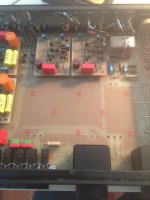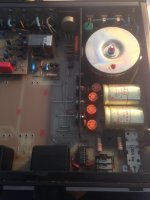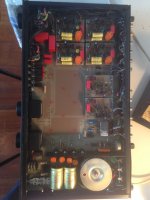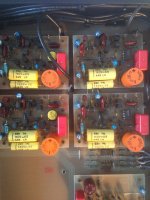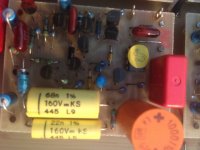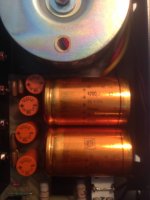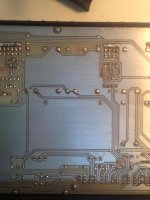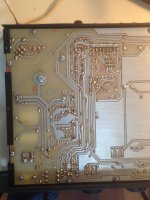Hi all,
I'm about to recap my Korn&Macway preamp.
I've just replaced the main PSU caps and the change I hear (for the better, and not by a small margin) encourages me to change the smaller decoupling caps as well.
I'm considering Elna Silmic II, seeing the good results I got from using those in my CD player, but maybe there are some options I'm not aware of, open to suggestions!
I've already changed the two 4700uF
I need:
100uF / 40v x4
1000uF / 10v (?) x4
220uF / 6v (?) x2
2,2uF / 63v x18
10uF / 63v x2
values based on what i read on the original caps, there's no schematics available for that rare made in Belgium preamp.
I'm about to recap my Korn&Macway preamp.
I've just replaced the main PSU caps and the change I hear (for the better, and not by a small margin) encourages me to change the smaller decoupling caps as well.
I'm considering Elna Silmic II, seeing the good results I got from using those in my CD player, but maybe there are some options I'm not aware of, open to suggestions!
I've already changed the two 4700uF
I need:
100uF / 40v x4
1000uF / 10v (?) x4
220uF / 6v (?) x2
2,2uF / 63v x18
10uF / 63v x2
values based on what i read on the original caps, there's no schematics available for that rare made in Belgium preamp.
Last edited:
get yourself an ESR tester and test each cap before replacing just to
be sure you are not throwing a good cap for a lemon....
be sure you are not throwing a good cap for a lemon....
some pictures
Attachments
I find the calender is the best electrolytic cap meter.get yourself an ESR tester and test each cap before replacing just to
be sure you are not throwing a good cap for a lemon....
Over 20 years of age in consumer audio, if the rubber seal of an e-cap hasn't failed today, it will tomorrow. If one e-cap has failed in a consumer audio device, once open I replace them all. After the all the freight on the box from the distributor costs more than 80 of the smaller caps. In devices where it is easy to operate the chassis, I change two at a time. You can usually hear the improvement of each pair of caps in a 25 year old device. I've put several hundred e-caps in these old organs.
I buy e-caps by service life, the longer the better. I had to replace them in my power amp 4 times using store shelf stock caps and that is too much work.
Suitable long life caps have been Nichicon UPT, LGY. LGR
Panasonic EEUEE, some sizes of EEUFR
Rubicon, I didn't keep the datasheet on the 8000 to 10000 hours caps.
You can get farnell to show you the hours service life in their selection chart. They have recently deleted it from the always shown catagory.
You can also get digikey to show the hours service life.
Mouser makes you download the datasheet to separate the **** from the good.
Most other vendors don't even have a link to the datasheet. Many vendors won't tell you brand or line.
CDE & United Chemicon have a looser standard for end of life, so their hours life published do not equal the above vendors numbers. I have also found caps from the latter two vendors come from a country noted for QA paperwork that doesn't reflect reality. Schools and bridges fell down, "baby formula" was really industrial cleaner.
Last edited:
I find the calender is the best electrolytic cap meter.
yes if date codes are printed on the label,
me i replace caps only when they really need replacing...
yes if date codes are printed on the label,
me i replace caps only when they really need replacing...
well, you don't know they need replacing until you replace them! that's the thing with vintage equipment! You think it works, only it doesn't really... 🙂
the age of the equipment is also a clue....
anything over ten years old is suspect....
but testing will confirm....all i am saying....
anything over ten years old is suspect....
but testing will confirm....all i am saying....
the age of the equipment is also a clue....
anything over ten years old is suspect....
but testing will confirm....all i am saying....
Well, so far I've had two full recaps done: first was an SAE Mark 1B (1976) preamplifier, recapped by professionals ; second was my revox B226 CD player (1987)
both recaps transformed fully functional, not noisy or humming, but mediocre-sounding units into very good sounding equipment...
On this KM preamp I'm about to do now, nothing except age (1980's) would let anyone believe it's in need of a recap; yet just changing two caps already made a significant difference.
I will therefore consider that any device older than, say, 20 years must be recapped if serious evaluation of its sonic capabilities is expected.
I have some vintage audio collector friends around me who wouldn't touch an amplifier before it fails, ok if you just collect shiny faceplates with fancy names, but if you're into serious listening I think that's ridiculous. But that's just my very humble opinion based on my own experience...
If historic rubber was good for anything, the Pebble Beach concours would run their vintage cars on vintage tires.I have some vintage audio collector friends around me who wouldn't touch an amplifier before it fails, ok if you just collect shiny faceplates with fancy names, but if you're into serious listening I think that's ridiculous. But that's just my very humble opinion based on my own experience...
Without a 85 deg soak in an environmental chamber, followed by the ESR test, you don't know anything about the state of the rubber seal of an old e-cap. Once cracked, the water will leak out in weeks of operation, or a couple of years of sitting on the shelf. The production date, and an inspection of the calender, will tell you the state of the rubber. There were some epoxy sealed caps, but only in medical equipment, not in consumer audio devices. I don't work on things that sound good and have enough sensitivity (for radios) but once there is a problem, out they all go. I've found carbon comp resistors over 100k to be suspect too, especially if not coated with the mil-spec type paint. (Allen Bradley and Sprague post 1961, if I read the appearance right of the good ones). Once the paint is burnt, all carbon comp resistors should be replaced.
Enjoy your vintage equipment. I do. I'm listening to a 1979 Reader's Digest All band radio right now, which had about 30 new caps in 2013. One Hammond organ took 71 of them.
There's 18 small 2,2uF electrolytics in my preamp
for those I consider elna silmic II, but browsing around I see that I can buy the same Roederstein shiny blue axial caps as the originals, new old stock, would that make any sense? do small caps have better or worse shelf life than big caps?
same goes for the 1000uF 10v on the MM and MC modules, they are originally Roederstein bakelite caps, I'm tempted to replace with Elna Silmic II or Nichicon KZ, but both might prove too high for the slim case of the preamplifier; the original bakelite caps are much shorter.
I can buy those "new old stock" as well, but again?..
for those I consider elna silmic II, but browsing around I see that I can buy the same Roederstein shiny blue axial caps as the originals, new old stock, would that make any sense? do small caps have better or worse shelf life than big caps?
same goes for the 1000uF 10v on the MM and MC modules, they are originally Roederstein bakelite caps, I'm tempted to replace with Elna Silmic II or Nichicon KZ, but both might prove too high for the slim case of the preamplifier; the original bakelite caps are much shorter.
I can buy those "new old stock" as well, but again?..
film caps are getting smaller and smaller, i will replace those 2.2uf ecaps with film types....
new old stock on caps? why bother? i will get the new production types...
why replace oldies with another oldie?
new old stock on caps? why bother? i will get the new production types...
why replace oldies with another oldie?
film caps are getting smaller and smaller, i will replace those 2.2uf ecaps with film types....
new old stock on caps? why bother? i will get the new production types...
why replace oldies with another oldie?
2,2uF >> WIMA MKS ?
those would fit!
mkp please....
MKP is four times the size and won't fit. There are 18 of those 2,2uF, and not much space! Isn't MKS better than electrolytic?
It is an experiment you will have to do. I'd say replace two at a time and see if anything bad happens. I replaced 10 paper dielectric 2.0 uf with polyester 2.2 uf roederstein caps and didn't like the brightness that resuslted.
Original aluminum electrolytic might sound more original, but have to be replaced again in 15 years. Yuuk. Newark won't show you the hours life anymore, I don't think even the 2.2 EEUFC's are 10000 hour service life caps in those tiny sizes.
Polyprophylene is supposed to be more stable dielectric than polyester, but my main source of polyprophylene in stock is Sprague orange drops, which are 400 v up rated (in stock) and HUGE.
I actually used 50 v rated CPO Aerovox gold ceramic caps in some places in my organ instead of 10 uf electrolytics. Size was determing, also a big closeout newark had on the aerovox. I think the low inductance ceramics gave snappier percussion, which made attack sound more like a Rhodes piano. Not an original sound, but very pleasing.
So this experiment has to be done by you, and if you don't like what happens you have some caps in the stock bag for future projects. Each circuit is different, unforunately.
If you really want to go wild, tantalum caps are low inductance, also have no service life rating at all. 9 of 12 tantalums in my 1968 organs were replaced under warrentee, and I got some bad ones at a local parts shop (popcorn noise), so I'm rather negative on tantalum.
Have fun experimenting.
Original aluminum electrolytic might sound more original, but have to be replaced again in 15 years. Yuuk. Newark won't show you the hours life anymore, I don't think even the 2.2 EEUFC's are 10000 hour service life caps in those tiny sizes.
Polyprophylene is supposed to be more stable dielectric than polyester, but my main source of polyprophylene in stock is Sprague orange drops, which are 400 v up rated (in stock) and HUGE.
I actually used 50 v rated CPO Aerovox gold ceramic caps in some places in my organ instead of 10 uf electrolytics. Size was determing, also a big closeout newark had on the aerovox. I think the low inductance ceramics gave snappier percussion, which made attack sound more like a Rhodes piano. Not an original sound, but very pleasing.
So this experiment has to be done by you, and if you don't like what happens you have some caps in the stock bag for future projects. Each circuit is different, unforunately.
If you really want to go wild, tantalum caps are low inductance, also have no service life rating at all. 9 of 12 tantalums in my 1968 organs were replaced under warrentee, and I got some bad ones at a local parts shop (popcorn noise), so I'm rather negative on tantalum.
Have fun experimenting.
Last edited:
Nichicon has an extensive lineup and routinely delivers good price performance. At least where I am they're often easier to source than Elna too.I'm considering Elna Silmic II, seeing the good results I got from using those in my CD player, but maybe there are some options I'm not aware of, open to suggestions!
It is an experiment you will have to do. I'd say replace two at a time and see if anything bad happens. I replaced 10 paper dielectric 2.0 uf with polyester 2.2 uf roederstein caps and didn't like the brightness that resuslted.
Original aluminum electrolytic might sound more original, but have to be replaced again in 15 years. Yuuk. Newark won't show you the hours life anymore, I don't think even the 2.2 EEUFC's are 10000 hour service life caps in those tiny sizes.
Polyprophylene is supposed to be more stable dielectric than polyester, but my main source of polyprophylene in stock is Sprague orange drops, which are 400 v up rated (in stock) and HUGE.
I actually used 50 v rated CPO Aerovox gold ceramic caps in some places in my organ instead of 10 uf electrolytics. Size was determing, also a big closeout newark had on the aerovox. I think the low inductance ceramics gave snappier percussion, which made attack sound more like a Rhodes piano. Not an original sound, but very pleasing.
So this experiment has to be done by you, and if you don't like what happens you have some caps in the stock bag for future projects. Each circuit is different, unforunately.
If you really want to go wild, tantalum caps are low inductance, also have no service life rating at all. 9 of 12 tantalums in my 1968 organs were replaced under warrentee, and I got some bad ones at a local parts shop (popcorn noise), so I'm rather negative on tantalum.
Have fun experimenting.
Thanks for your input.
I've ordered everything in Elna Silmic II. The four 100uF 40v that are on the PSU board just after the two 4700uF I've ordered NOS Roederstein "golden bullets" EKM series. The two 4700uF are NOS Roederstein and they sound soooooo good, I wanna give these a try. I will compare between that and Elna before recapping the rest. I don't dare to use tantalums because I don't have the schematics and I'm not good enough in electronics to always see wich caps is on the signal path and wich cap isn't. Tantalum dosn't have such a briliant reputation (I guess?), even tho Naim uses them a lot in their gear...
For the best results, replace like with like. NOS are old are will need reforming before use, if they can be reformed.
Performed the recap last night.
Due to the difficulty of taking the unit apart (line level preamp modules on separate PCBs, a half inch above main PCB/ground plane, soldered to it), I had to do all caps at once. The MM and MC phono pcbs I will tackle later, as I'm not using vinyl as a source for now.
Well... right now the sound is quite disappointing; extreme frequencies are bloated like an amplifier trying too hard to impress (entry-level NAD style 😀 )
BUT I experienced similar result when recapping my Revox B226. Silmics II take a long time to bed in and open up greatly after between 50 and 100hours. These have seen only 5 hours of music so far.
I'll wait at least one week before making a definitive judgement on the sound.
Due to the difficulty of taking the unit apart (line level preamp modules on separate PCBs, a half inch above main PCB/ground plane, soldered to it), I had to do all caps at once. The MM and MC phono pcbs I will tackle later, as I'm not using vinyl as a source for now.
Well... right now the sound is quite disappointing; extreme frequencies are bloated like an amplifier trying too hard to impress (entry-level NAD style 😀 )
BUT I experienced similar result when recapping my Revox B226. Silmics II take a long time to bed in and open up greatly after between 50 and 100hours. These have seen only 5 hours of music so far.
I'll wait at least one week before making a definitive judgement on the sound.
- Status
- Not open for further replies.
- Home
- Source & Line
- Analog Line Level
- Recommandations for electrolytic capacitors / preamp recap

